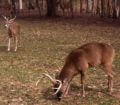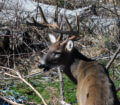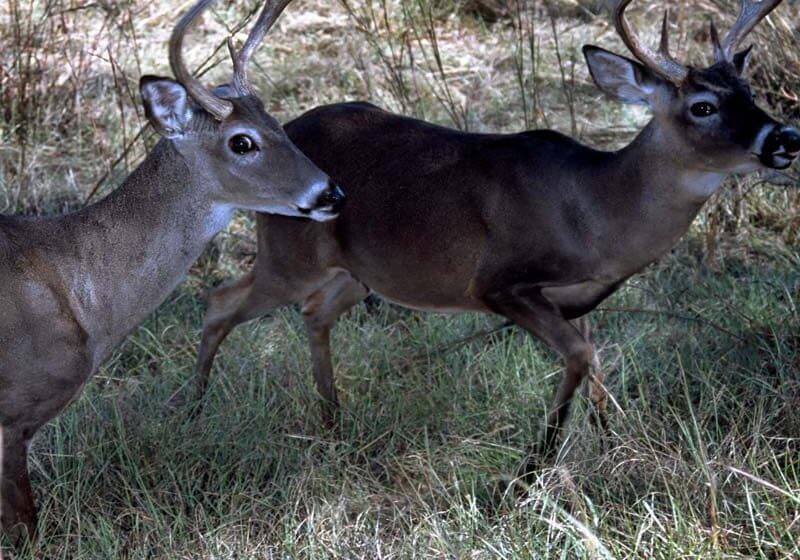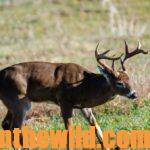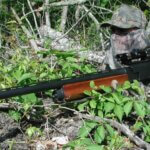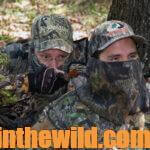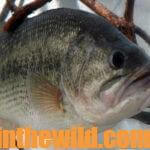John’s Note: When you’re hunting over fields, whether snow fields in Canada or agricultural fields in the South, the same equipment for accurate shooting is required. Only the temperature varies. With a flat-shooting rifle, a quality scope and a cartridge that consistently shoots 1- to 2-inch groups, you can shoot with confidence at ranges of more than 100 yards in pastures and croplands.
Bucks usually will move into croplands to feed late in the evening and go out of the crops early in the morning. However, after the crops have been harvested, or if you hunt over pastures or green fields, deer may cross these fields at any time of the day. Often the middle of the day is the best time to catch deer crossing agricultural fields, since that’s when hunting pressure tends to be the lightest. The deer won’t be as reluctant to move at that time.
 To hunt an agricultural field early in the morning, plan to arrive at the field an hour before daylight. Climb into your tree stand as quietly as possible. Many hunters spook the deer they may have the chance to take because of making far-too-much noise going to their stands and climbing into their stands. Remember that sound carries a great distance in open country. Put your tree stand up the day before you plan to hunt. By allowing yourself more time than you think you need and getting into your stand before daylight, you’ll climb much more quietly and take more time getting set-up properly in the stand. If you hunt in the afternoon, go to your stand 2-3 hours before dusk. Often hunters arrive at their stands too late, especially in the afternoons during the rut. Because big bucks chase does and move all day long during the rut, the likelihood of your seeing a trophy deer coming across a field and croplands can occur at any time.
To hunt an agricultural field early in the morning, plan to arrive at the field an hour before daylight. Climb into your tree stand as quietly as possible. Many hunters spook the deer they may have the chance to take because of making far-too-much noise going to their stands and climbing into their stands. Remember that sound carries a great distance in open country. Put your tree stand up the day before you plan to hunt. By allowing yourself more time than you think you need and getting into your stand before daylight, you’ll climb much more quietly and take more time getting set-up properly in the stand. If you hunt in the afternoon, go to your stand 2-3 hours before dusk. Often hunters arrive at their stands too late, especially in the afternoons during the rut. Because big bucks chase does and move all day long during the rut, the likelihood of your seeing a trophy deer coming across a field and croplands can occur at any time.
Some years ago, I decided to hunt on the edge of a cornfield where the corn had been harvested early in the summer for roasting ears. The stalks had been cut down and left to rot in the field. Although the cornfield appeared to have nothing that would draw deer to it, some fresh young shoots of grass and weeds grew up between the rows. I discovered does feeding there. By scouting the fields, I also pinpointed some well-defined trails and scrapes along their edges. Knowing that bucks would appear at a scrape at almost any time during the rut and realizing the does already were feeding on the winter grass in the green field, I went to my stand at 1:00 pm. As I slowly climbed the tree to reach my stand, I spotted movement about 75-yards away with my Nikon (https://www.nikonsportoptics.com) binoculars. A buck stood about 20 yards from his scrape, eying a doe already out in the field. As I tried to calm myself down, I noticed the buck looking in my direction. However, because the wind was in my favor, and I remained motionless in my Mossy Oak (http://www.mossyoak.com/) camouflage, the deer never spotted me. I took my time and mounted my rifle. My rifle reported just as the buck took his first step out into the field. The buck fell.
Although dusk and dawn are the most-productive times to take a white-tailed deer along agricultural fields during the rut, even when the crop has been harvested, you often can find bucks moving on the edges of abandoned fields where they leave scrapes and feed on grasses growing up after the crops have been harvested.
Many states issue crop-deprivation permits and allow landowners to kill deer when the animals are destroying crops. The cropland hunter can be used as a management tool to control deer herds on croplands and often is welcomed by the landowner. In most farming regions, the deer the landowner want to see gone the most are the antlerless deer. These animals represent the reproductive segment in the herd and are the least attractive to the hunter. The bucks have value, are the most desirable for hunting and will bring the biggest price to the landowner in the form of leasing his land to hunt.
By understanding the economic value of the deer that destroy the crops, you often can find good croplands to hunt. Here’s how:
1) Check with your county extension agent and county conservation officer to see if any crop-deprivation permits have been issued in your county or in the counties you want to hunt. Once you know which croplands have deer problems, you may locate a deer honey hole.
2) Contact the landowner(s). Offer to take off the surplus of antlerless deer he needs removed, if he will let you hunt for bucks. Since the bucks have value, the landowner may offer the legal limit of bucks in exchange for your harvesting the antlerless deer. Discuss the antlerless harvest with the landowner and the conservation officer in the area you hunt. Often you can donate the meat of these nuisance animals to some charity.
3) Learn where, how and when to hunt the croplands by removing the deer that are destroying the crops. You also will find the bucks you want to hunt when the season arrives. By solving the farmer’s nuisance deer problem, you often can locate a productive place to hunt, provide food for the needy and locate big bucks to hunt later.
No one likes to see deer wasted, but the farmer has to protect his crops. By your becoming the management tool the farmers use for deer control, you often can find and bag the buck of your dreams.
4) Use another tool to identify croplands – the map service at www.mytopo.com. You can order maps of any property in the United States where you want to hunt. One of the great new features that www.mytopo.com has started adding to its maps are boundary lines on all the properties on the map, as well as the landowners’ names. Using several different maps, you often can find small overlooked lands to hunt that you may be able to obtain permission to hunt for free or to lease at a reasonable price. The website www.mytopo.com has topographical maps and also aerial photos of properties with boundary lines and the property owner’s name. Once you choose the maps most important to you, www.mytopo.com will make these maps for you and laminate them so you can carry them with you.
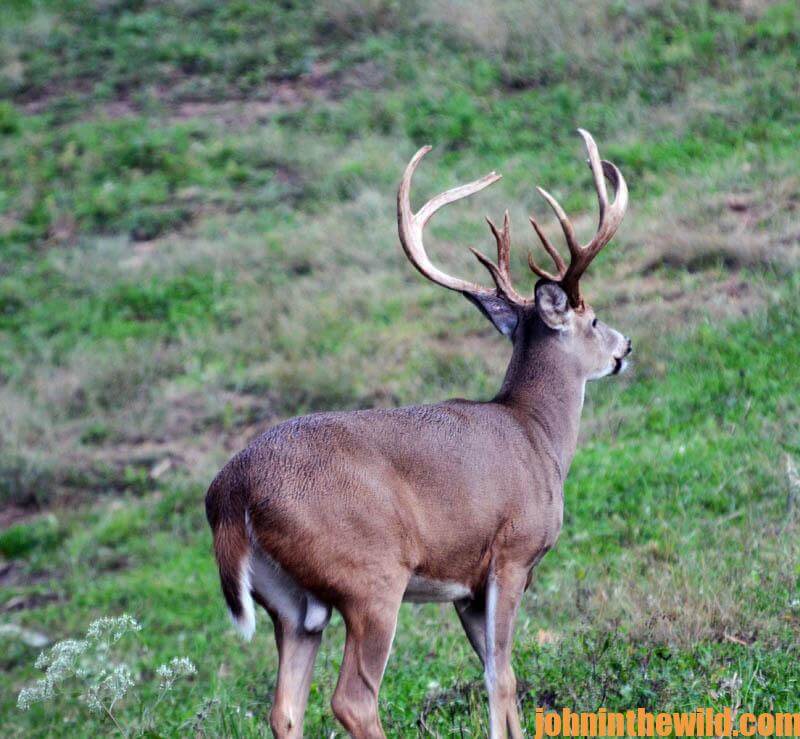 To get John E. Phillips’ eBooks and print books on hunting deer, including his newest deer-hunting book, “Whitetail Deer and the Hunters Who Take Big Bucks,” available at http://amzn.to/2bYwYOK/, click on these books to learn more, “How to Hunt and Take Big Buck Deer on Small Properties,” “How to Hunt Deer Up Close: With Bows, Rifles, Muzzleloaders and Crossbows,” “PhD Whitetails: How to Hunt and Take the Smartest Deer on Any Property,” “How to Take Monster Bucks,” “How to Hunt Deer Like a Pro,” and “Bowhunting Deer: Mossy Oak Pros Know Bucks and Bows,” or to prepare venison, “Deer & Fixings.” Or, go to www.amazon.com/kindle-ebooks, type in the name of the book, and download it to your Kindle, and/or download a Kindle app for your iPad, SmartPhone or computer. You also can find John’s books on Nook at www.barnesandnoble.com.
To get John E. Phillips’ eBooks and print books on hunting deer, including his newest deer-hunting book, “Whitetail Deer and the Hunters Who Take Big Bucks,” available at http://amzn.to/2bYwYOK/, click on these books to learn more, “How to Hunt and Take Big Buck Deer on Small Properties,” “How to Hunt Deer Up Close: With Bows, Rifles, Muzzleloaders and Crossbows,” “PhD Whitetails: How to Hunt and Take the Smartest Deer on Any Property,” “How to Take Monster Bucks,” “How to Hunt Deer Like a Pro,” and “Bowhunting Deer: Mossy Oak Pros Know Bucks and Bows,” or to prepare venison, “Deer & Fixings.” Or, go to www.amazon.com/kindle-ebooks, type in the name of the book, and download it to your Kindle, and/or download a Kindle app for your iPad, SmartPhone or computer. You also can find John’s books on Nook at www.barnesandnoble.com.
For free information on making jerky from your deer to provide a protein-rich snack, you can download a free book from https://johninthewild.com/free-books.

